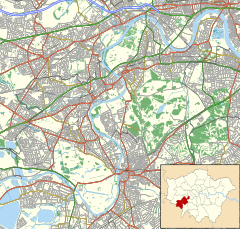
Back Hampton Court-paleis Afrikaans قصر هامبتون كورت Arabic قصر هامبتون كورت ARZ Hempton Kort Azerbaijani Хэмптан-корт Byelorussian Хемптън корт (дворец) Bulgarian Palau de Hampton Court Catalan Hampton Court Palace Czech Hampton Court Palace Danish Hampton Court Palace German
| Hampton Court Palace | |
|---|---|
 The Tudor Great Gatehouse | |
| General information | |
| Location | Hampton Court, Greater London, England |
| Coordinates | 51°24′12″N 0°20′15″W / 51.40333°N 0.33750°W |
| Current tenants | Historic Royal Palaces |
| Owner | Charles III in right of the Crown[1] |
| Website | |
| www | |
Listed Building – Grade I | |
| Official name | Hampton Court Palace |
| Designated | 2 September 1952 |
| Reference no. | 1193127 |
Hampton Court Palace is a Grade I listed[2] royal palace in the London Borough of Richmond upon Thames, 12 miles (19 kilometres) southwest and upstream of central London on the River Thames. Opened to the public, the palace is managed by Historic Royal Palaces, a charity set up to preserve several unoccupied royal properties.
The building of the palace began in 1514 for Cardinal Thomas Wolsey, the chief minister of Henry VIII. In 1529, as Wolsey fell from favour, the cardinal gave the palace to the king to check his disgrace. The palace went on to become one of Henry's most favoured residences; soon after acquiring the property, he arranged for it to be enlarged so it could accommodate his sizeable retinue of courtiers.
In the early 1690s, William III's massive rebuilding and expansion work, which was intended to rival the Palace of Versailles, destroyed much of the Tudor palace.[3] His work ceased in 1694, leaving the palace in two distinct contrasting architectural styles, domestic Tudor and Baroque. While the palace's styles are an accident of fate, a unity exists due to the use of pink bricks and a symmetrical, if vague, balancing of successive low wings.[4] George II was the last monarch to reside in the palace.
The palace is open to the public and a major tourist attraction, reached by train from Waterloo station in central London and served by Hampton Court railway station in East Molesey. Buses 111, 216, 411 and R68 stop outside the gates. The structure and grounds are cared for by an independent charity, Historic Royal Palaces, which receives no funding from the Government or the Crown.[5] The palace displays many works of art from the Royal Collection.
Apart from the palace itself and its gardens, other points of interest for visitors include the celebrated maze, the historic royal tennis court (see below), and a huge grape vine, the world's largest as of 2005[update]. The palace's Home Park is the site of the annual Hampton Court Palace Festival and Hampton Court Garden Festival.
- ^ "History". Historic Royal Palaces. Retrieved 22 July 2013.
- ^ Historic England (2 September 1952). "Hampton Court Palace (1193127)". National Heritage List for England. Retrieved 28 July 2020.
- ^ Dynes, p. 90.
- ^ Dynes, p. 86.
- ^ "Who we are". Historic Royal Palaces. Archived from the original on 1 September 2011. Retrieved 12 July 2011.
© MMXXIII Rich X Search. We shall prevail. All rights reserved. Rich X Search
